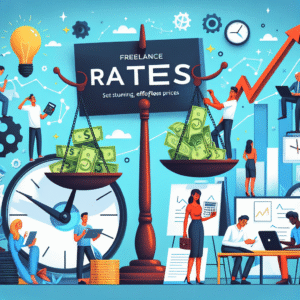Freelance Rates: Set Stunning, Effortless Prices That Reflect Your True Value
Freelance rates are one of the most important — and often misunderstood — elements of thriving in today’s remote work economy. Whether you’re a digital nomad, a seasoned freelancer, or transitioning from corporate life to self-employment, your pricing strategy can make or break your business.
Pricing freelance work isn’t just about charging what your competitors do or guessing based on what feels “fair.” It’s about aligning your rates with your value, your goals, and the market — without overcomplicating the process.
In this guide, we’ll explore how to set freelance rates that feel effortless, communicate confidence, and actually move your freelance career forward.
—
Why Getting Your Freelance Rates Right Is Crucial

Setting the right freelance rates does more than just fill your bank account — it defines your positioning. Inconsistent or underpriced services not only attract the wrong clients but also hurt your long-term growth.
Here’s what strong freelance pricing can do for you:
– Attract high-quality clients who respect your time and expertise
– Reduce burnout by fairly compensating your effort
– Increase long-term revenue and sustainability
– Boost confidence in sales conversations
– Position you as a premium provider in your industry
Regardless of your niche — whether you’re a freelance designer, writer, developer, or marketing consultant — getting your rates right is one of the most powerful career moves you can make.
—
1. Understand Your Baseline: What You Actually Need to Earn
Before picking a number that feels exciting, you’ll want a clear picture of what you need to earn.
Start with your monthly income goal.
Include expenses like:
– Rent or mortgage
– Software subscriptions
– Insurance or healthcare
– Savings, taxes, and retirement contributions
– Vacation time (you’re allowed to take breaks!)
Now, divide the total by your realistic billable hours per month. Not all 160 hours in a month are billable — think admin time, emails, meetings, etc. For most freelancers, 20–25 billable hours per week is realistic.
From here, calculate a minimum viable hourly rate — a baseline figure to keep you on track.
> Example:
> Monthly income goal: $6,000
> Billable hours/month: 100
> Minimum hourly rate: $6,000 ÷ 100 = $60/hour
This is not your final rate, but it gives you clarity on the floor you should never drop below.
—
2. Explore Pricing Models Beyond the Hourly Rate
Hourly rates are common, but they’re not always the smartest model. In fact, many top freelancers avoid hourly pricing for one simple reason: it limits your income potential.
Here are three smarter alternatives:
• Project-based pricing
Great for predictable deliverables. Charging per project allows you to disconnect time from value. The more efficient you become, the better your profit margins.
• Value-based pricing
This model charges based on the potential outcome for the client. For example, if your copywriting is helping an eCommerce brand make an extra $50,000 a month, charging $3,000–$5,000 for the project might actually be a bargain.
• Retainer pricing
Ideal for long-term clients. You offer a fixed monthly fee in exchange for a set number of services or hours. This provides predictability for you and ongoing support for the client.
Tip: Test different hybrid models. Some freelancers charge hourly for initial consulting, project rates for deliverables, and retainers for ongoing work.
—
3. Research Freelance Market Rates in Your Industry
To have confidence in your rates, you need context. Use platforms like:
– Upwork and Fiverr Pro: Look at top-rated profiles in your niche
– Glassdoor/Freelancer’s Union: Find benchmark salaries and freelance equivalents
– Twitter & LinkedIn: Ask your network or search discussions on rates
– Remote job boards (We Work Remotely, Remote OK): Check compensation ranges
But remember — don’t race to the bottom. Competing purely on price can trap you in inconsistent, underpaid work. Instead, use these insights to position yourself strategically, not cheaply.
—
4. Factors That Influence Stunning Freelance Rates
Clients don’t pay based on your needs — they pay based on your perceived value. So if you want to increase rates confidently and effortlessly, make sure your overall brand position justifies it.
Here’s how to amplify your freelance brand:
• Specialize:
Being a “general writer” might command $50/hour. Being a “SaaS email conversion copywriter” could easily justify $150+/hour.
• Build social proof:
Case studies, testimonials, LinkedIn recommendations, or portfolio highlights make your rates feel logical, not optional.
• Show results, not just process:
Clients don’t buy time; they buy outcomes. Sell the transformation — not the task list.
• Upskill strategically:
Tools like HubSpot Academy, Skillshare, or Coursera can teach you premium-demand skills like UX design, AI-enhanced writing, or CRO marketing. These skills command higher prices.
—
5. How to Communicate Your Freelance Rates with Confidence
Even the best rate is meaningless if you stumble when quoting it. Here’s how to talk about pricing naturally:
Set expectations early.
Don’t wait until after two calls and a detailed proposal to talk money. Bring up budget early on. You can say:
> “For similar projects, I typically work within the $2–5K range. Does that align with what you had in mind?”
Quantify your value.
Help clients see the return on your fee. If your $2,000 social media campaign drives $8,000 in new sales, your price seems like a good investment.
Stay silent after quoting.
Silence during negotiations is powerful. Quote your price, then pause and let the client respond.
—
6. When and How to Raise Your Rates as a Freelancer
If your skills have grown, your rates should too. Review and adjust your pricing every 6–12 months. Here’s when to confidently raise rates:
– You’re regularly booked out or saying no to work
– You’ve added new expertise or certifications
– You’ve improved your process and results
– You’re hearing “yes” too quickly in sales calls
How to do it:
– For new clients, just update your pricing in your proposals and platforms.
– For existing clients, give 30 days’ notice and frame it around your added value:
> “As we’ve grown together and I’ve increased both the efficiency and scope of the work I provide, I’m updating my pricing to more closely reflect the results I’m focused on delivering.”
—
Conclusion: Pricing Isn’t Guesswork — It’s Strategy
Finding that sweet spot for your freelance rates doesn’t have to be stressful. With a clear method, market research, a value-first mindset, and client communication that reflects your professionalism, setting stunning, effortless prices becomes your new norm.
This isn’t (Incomplete: max_output_tokens)


8 thoughts on “Freelance Rates: Set Stunning, Effortless Prices”